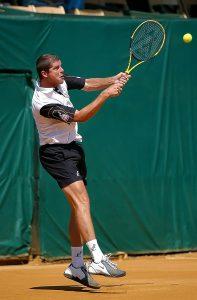We may earn money or products from the companies mentioned in this post.
The Science and Purpose of Pressurized Tennis Balls

When it comes to playing tennis, the type of ball you use can make all the difference in your game You may have noticed that tennis balls are available in different variations, but have you ever wondered why some tennis balls are pressurized? In this article, we will explore the science behind pressurized tennis balls and why they are an essential component of the sport
Overview of Tennis Ball Types
Before diving into the specifics of pressurized tennis balls, let’s take a moment to understand the different types available on the market There are two main categories: pressurized and pressureless tennis balls
Pressurized tennis balls, as the name suggests, are filled with air under high pressure This creates a lively bounce and enhances the overall performance on the court On the other hand, pressureless tennis balls do not contain any internal pressure and rely on their solid core for bounce
The Importance of Pressure in Tennis Balls
Now that we know about the two types of tennis balls, let’s delve into why pressurization is such a crucial aspect The primary reason for pressurizing tennis balls is to optimize their bounce characteristics during play
Tennis is a fast-paced sport that requires quick reflexes and precise shots When a player hits a ball with their racket, they expect it to rebound off their opponent’s side with enough force and consistency This is where pressurization comes into play
The high internal pressure in pressurized tennis balls enables them to compress upon impact and then quickly regain their original shape when released from the racket strings This rapid compression-and-release cycle generates an energetic bounce that allows players to anticipate and respond effectively during rallies
Furthermore, the pressurization also affects the durability of tennis balls The air pressure inside helps maintain the ball’s structural integrity and prevents it from going flat too quickly This means that pressurized tennis balls retain their bounce for a longer period, ensuring a consistent playing experience
In contrast, pressureless tennis balls, which lack internal pressure, tend to have a lower bounce and lose their felt covering over time This makes them more suitable for recreational play or training purposes where extended durability is prioritized over high-performance characteristics
It is worth noting that the choice between pressurized and pressureless tennis balls ultimately depends on personal preference and playing style Professional players often opt for pressurized balls due to their superior performance qualities, while amateur players may find pressureless balls more suitable for their needs
In Conclusion

In conclusion, pressurized tennis balls are an integral part of the sport due to their ability to deliver consistent bounce and durability The high internal pressure allows for energetic rebounds during gameplay, enhancing player performance Understanding the science behind pressurization can help you make informed decisions when selecting the perfect tennis ball for your game
The Physics Behind Pressurized Tennis Balls

Understanding Air Pressure
Have you ever wondered why tennis balls are so bouncy? The answer lies in the fascinating world of air pressure Air pressure refers to the force exerted by the air molecules on any given surface In sports equipment, such as tennis balls, air pressure plays a crucial role in determining their performance
Gas laws, formulated by brilliant minds like Boyle and Charles, provide insights into the behavior of gases under different conditions These laws help us understand how pressurization works In the case of pressurized tennis balls, high internal pressure is achieved by pumping large amounts of air into them
Effects of Pressure on Ball Performance
1 Bounce characteristics due to internal pressure
a) When a pressurized tennis ball comes into contact with the ground, its high internal pressure causes it to compress rapidly This compression stores potential energy within the ball, which is released upon bouncing back up The higher the internal pressure, the greater the bounce height and speed
b) Comparing pressurized balls with non-pressurized ones reveals a significant difference in control during gameplay Pressurized balls offer better control due to their predictable bounce behavior, allowing players to make precise shots and take advantage of strategic positioning
2 Spin potential influenced by pressurization
a) Topspin, backspin, and sidespin are essential techniques used by tennis players to manipulate the trajectory and movement of the ball through spin generation Pressurization affects spin potential by altering how friction between the ball and racket strings is managed during contact
b) With increased internal pressure in a tennis ball, more deformation occurs upon impact with racket strings or court surface This deformation allows for enhanced grip between the ball and strings, enabling players to generate more spin and control the ball’s flight path with precision
Understanding the physics behind pressurized tennis balls provides valuable insights into how they perform on the court The interplay between air pressure, bounce characteristics, and spin potential creates an exciting dynamic that adds depth to the game of tennis So, next time you step onto the court, remember that it’s not just your skills but also the physics behind those bouncy balls that can make all the difference in your gameplay!
Manufacturing Process: Creating Pressurized Tennis Balls

When it comes to manufacturing pressurized tennis balls, the materials used play a crucial role in ensuring their performance on the court Let’s delve into the fascinating world of tennis ball construction and explore the different elements involved
Materials Used for Construction
In order to create a durable and responsive tennis ball, two main components are essential – the rubber core and the shell or cover material
1 Rubber Core Composition
The rubber core is at the heart of every tennis ball, determining its bounce and overall feel Manufacturers have a choice between natural rubber and synthetic rubber materials when crafting this vital component
Natural rubber, derived from latex harvested from rubber trees, offers excellent elasticity and responsiveness on the court Its organic nature provides a unique touch that many players appreciate On the other hand, synthetic rubbers offer enhanced durability and consistency in performance over time
2Shell or Cover Material Options
The outermost layer of a tennis ball, known as the shell or cover, is responsible for providing grip during play and protecting the internal components The most common material used for this purpose is felt
Felt comes in various types, with nylon and wool being popular choices among manufacturers Nylon felt offers exceptional durability while maintaining good playing characteristics Wool felt, on the other hand, provides superior grip and control but may wear out faster compared to its nylon counterpart
Pressure Sealing Techniques: Encapsulation Methods
Maintaining consistent pressure within a tennis ball is crucial for ensuring optimal performance on the court To achieve this, manufacturers employ pressure sealing techniques during production
1Vacuum Sealing Process for Maintaining Pressure Levels
One common method used is the vacuum sealing process After the rubber core and shell materials are combined, the tennis balls are placed in a specialized chamber where the air is removed, creating a vacuum This vacuum allows the pressure within the ball to equalize and stabilize at the desired level
Once the desired pressure is achieved, the balls are sealed to maintain their internal environment This encapsulation method ensures that each tennis ball retains its optimal bounce and performance throughout its lifespan
And there you have it – an inside look at the manufacturing process behind pressurized tennis balls From selecting the right rubber core composition to choosing between different cover materials, every aspect contributes to delivering a high-quality product that meets players’ expectations on the court
Benefits & Drawbacks of Pressurized Tennis Balls

Tennis, a game known for its fast-paced action and strategic gameplay, heavily relies on the performance of the balls used One popular option in the tennis world is pressurized tennis balls These balls, filled with compressed air, offer several advantages that enhance the overall playing experience However, they also come with their fair share of drawbacks and considerations to keep in mind
Advantages: Enhanced Playing Experience
When it comes to pressurized tennis balls, one of the key advantages lies in their playability factors The consistent bounce they provide allows players to anticipate shots accurately and plan their moves accordingly Whether you’re serving or returning a powerful forehand, knowing how the ball will behave upon impact can make all the difference
Additionally, pressurized tennis balls offer greater spin potential compared to non-pressurized alternatives The increased pressure inside these balls allows for more friction between the ball and the racket strings when struck at an angle, resulting in enhanced topspin or slice shots
Disadvantages: Degradation Over Time & Environmental Concerns
Despite their benefits, pressurized tennis balls are not without their drawbacks Over time, these balls tend to lose pressure and experience changes in performance As a result, they may not bounce as consistently or provide optimal playability after extended use
To mitigate this disadvantage, players need to consider the lifespan of pressurized tennis balls Regularly replacing them can help maintain peak performance levels during matches or practice sessions
-
Lifespan considerations when using pressurized balls:
While there is no set expiration date for pressurized tennis balls, it’s important to note that their performance gradually declines over time Factors such as frequency of use, court surface, and storage conditions can affect their durability
Moreover, the production and disposal of tennis balls, including pressurized ones, have environmental implications The manufacturing process involves the use of various materials and energy resources Additionally, when these balls reach the end of their usable life, they often end up in landfills where they contribute to waste accumulation
To address these concerns, efforts are being made to develop more sustainable alternatives to traditional tennis balls These eco-friendly options aim to reduce environmental impact without compromising on performance
Conclusion & Final Thoughts

After exploring the importance of pressurization in tennis balls and providing guidance on choosing the right ball, it is clear that the pressure inside a tennis ball has a significant impact on both the playing experience and performance Pressurized tennis balls offer greater bounce and speed, making them ideal for competitive play On the other hand, pressureless tennis balls provide durability and consistency, making them suitable for practice sessions
Recapitulation: Importance of Pressurization in Tennis Balls
The pressurization of tennis balls plays a crucial role in dictating how they perform on the court When a tennis ball is pressurized, it becomes more lively and bouncy This enhanced bounce not only adds excitement to the game but also affects how players strategize their shots The increased speed allows for quicker rallies and requires players to react faster, leading to an exhilarating and dynamic playing experience
Guidance for Players: Choosing the Right Tennis Ball
When it comes to selecting the appropriate tennis ball, there are several factors to consider such as skill level and personal preference Beginners or recreational players may opt for low-pressure or pressureless balls as they provide more control and are easier to handle Intermediate or advanced players often prefer high-pressure balls that offer greater power and speed
Additionally, considering personal preference is essential since each player may have different preferences regarding ball feel, spin potential, and overall performance Some players may prioritize durability over performance while others may focus on maximizing their game with high-performance balls
In conclusion, understanding the significance of pressurization in tennis balls can greatly enhance your game By choosing the right type of ball based on your skill level and preferences, you can optimize your playing experience while improving your overall performance on the court
Useful Links

Why Are Tennis Balls Pressurized? – The Racket Life
Why Are Tennis Balls In Pressurized Cans? …
Why Tennis Balls Are Sealed In Cans
ELI5: Why do tennis balls come in a sealed container?
How to Choose the Right Type of Tennis Ball
4 Reasons Why Tennis Balls Are Pressurized
How Long Before a Tennis Ball Loses its Bounce? And …
Pressurized vs. Non-Pressurized Tennis Balls
Tennis Ball Saver – Good Idea or Useless Equipment?
Gexco Tennis Ball Saver – Pressurized …
Pressurized vs Pressureless Tennis Balls
FAQ – A Guide to Tennis Ball Pressurizers
Athletic Works Pressurized Tennis Balls, (1 Can, 3 Balls)
Definition, Examples, and Common Questions About The Ball
Why Do Tennis Balls Come in Pressurized Cans?
Tennis ball
How to Choose the Right Tennis Balls
Pressurized Tennis Balls | Babolat Official Website
Pressure VS Pressureless Tennis Balls | E.06 – YouTube






